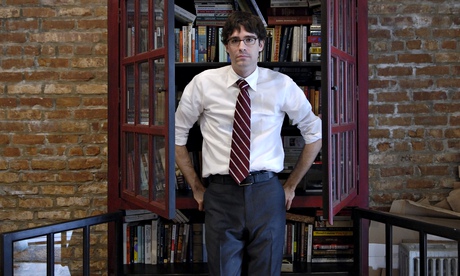In the year the Americans were feared to be taking over, only two ended up as finalists, with familiar British stars alongside them

Off the shelf … shortlistee Joshua Ferris. Photograph: Andrew Testa / Rex Features
This was the year the Americans were coming – but they weren't the ones we were expecting. Donna Tartt didn't even make it to the longlist, and now the Booker judges have passed over grandees Richard Powers and Siri Hustvedt in favour of Joshua Ferris, the youngest writer on the list, with To Rise Again at a Decent Hour, a black comedy about modern American life both on- and offline; and Karen Joy Fowler, whose cautionary tale We Are All Completely Beside Ourselves looks at first like a traditional family narrative but reveals itself to be something much stranger.
If there were fears of a wipeout, then, this is a measured list, with half the places taken by British authors (the surprise omission here is David Mitchell, whose globetrotting, time-travelling fantasy epic The Bone Clocks looked as though it might be all-conquering). The Commonwealth is represented by Richard Flanagan's bravura novel about the experiences of Australian soldiers in the second world war, The Narrow Road to the Deep North; there's a novel set in the subcontinent in the shape of Neel Mukherjee's The Lives of Others; and two out of the six authors are female, following raised eyebrows when women made up just three of the 13-strong longlist.
It may have felt at first like a year of surprises, but Howard Jacobson and Ali Smith, for British readers probably the best-known writers on the list, are no strangers to Booker shortlisting. J is a bold departure for Jacobson, though: a satire on conformism and anti-semitism set in an alternative Britain that the Guardian's review said "may well come to be seen as the dystopian British novel of its times".
Smith has always been a refreshingly unconventional writer, and How to Be Both is a typically playful novel in two parts, both titled "One", and published in two print runs so that half its readers will begin the book in the company of a disembodied Italian Renaissance artist looking back on her life, and half with a contemporary teenager in mourning for her mother. It's a love letter to art and art's possibilities; the human connections erased by history, and the beauty that endures. Down-to-earth, funny, profound and deeply moving, it could make a fitting winner for a prize in the process of reinvention.
If there were fears of a wipeout, then, this is a measured list, with half the places taken by British authors (the surprise omission here is David Mitchell, whose globetrotting, time-travelling fantasy epic The Bone Clocks looked as though it might be all-conquering). The Commonwealth is represented by Richard Flanagan's bravura novel about the experiences of Australian soldiers in the second world war, The Narrow Road to the Deep North; there's a novel set in the subcontinent in the shape of Neel Mukherjee's The Lives of Others; and two out of the six authors are female, following raised eyebrows when women made up just three of the 13-strong longlist.
It may have felt at first like a year of surprises, but Howard Jacobson and Ali Smith, for British readers probably the best-known writers on the list, are no strangers to Booker shortlisting. J is a bold departure for Jacobson, though: a satire on conformism and anti-semitism set in an alternative Britain that the Guardian's review said "may well come to be seen as the dystopian British novel of its times".
Smith has always been a refreshingly unconventional writer, and How to Be Both is a typically playful novel in two parts, both titled "One", and published in two print runs so that half its readers will begin the book in the company of a disembodied Italian Renaissance artist looking back on her life, and half with a contemporary teenager in mourning for her mother. It's a love letter to art and art's possibilities; the human connections erased by history, and the beauty that endures. Down-to-earth, funny, profound and deeply moving, it could make a fitting winner for a prize in the process of reinvention.
No comments:
Post a Comment